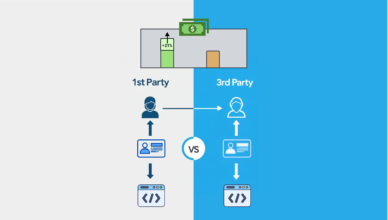If you work in media, you know how fundamental data is to your future success. Especially as maintaining control over your data brings you closer to your audience. Yet navigating consumer trust, privacy regulation and the complexity of the ecosystem can often leave publishers wondering if the data they hold is as robust as it could be. At the same time, it’s never been more important to pay attention to your data strategy given the degradation of third-party cookies and the identifiers, and the increasing challenge for publishers to attract advertisers – a problem exasperated by the COVID-19 pandemic.
So how can publishers achieve data excellence?
In this column, I’ve outlined five steps publishers could take to ensure their data house is in order.
Step One – Connect the data silos
As the industry has matured so too has the way in which we reach our consumers. Although we should celebrate the variety of channels we have to connect with our target audiences, it often leads to fragmentation and data silos. Any first step, therefore, is for businesses to unify the data they hold to ensure a holistic view. Until data is resolved into a durable, people-based ID, it’s almost impossible to move forward with a holistic approach.
Step two – Ensure senior buy-in
Data silos often exist due to company politics, where individual senior executives have ownership and control over different data segments, making effective collaboration problematic. For example, departments might focus on their own needs first, so if a piece of technology is needed to move a project forward, it may not be evaluated as a whole company and instead is implemented at a departmental level – this is often where many silos occur.
Data governance is also an understandable barrier and while it is vital that organisations have data governance in place, it can be an obstacle to change.
By securing senior buy-in on your data strategy it should be possible to tackle any data silos resulting from company politics or data governance. When there is a clear data strategy from the top, it’s very hard for department leads to get in the way of forwarding that strategy. And, with a degree of flexibility, data governance will be a critical complement, adding transparency and consistency while upholding the proper protection policies and processes.
Step three – Embrace data collaboration
Consider collaborating with other companies in your “ecosystem” – e.g. retailers, manufacturers, or other publishers. The ecosystem is vast but different partners will bring something else to the table. However, make sure you prioritise the right partners by ensuring they have a global footprint and have privacy at the heart.
Data collaborations can bring immense value by harnessing the capabilities and assets of other providers and enriching a publisher’s own data set. As a result, publishers will see more opportunities for growth and better understand the full journey of their customers which in turn improves measurement and provides actionable insight. Increasingly, I believe businesses that build powerful data collaborations to create differentiation will win in this space.
Step four – Test what works
I can’t emphasise enough the value of testing to see what works for your audience in terms of getting their opt in. Testing and learning, and talking to customers about what you’re doing, is the best way to ensure you are providing consumers with control and transparency, both of which translate to trust. We also know that consumers who trust organisations are far more likely to provide their consent.
It’s advisable to go for a lot of tests and avoid jumping into big decisions around data. When companies dive in head first, it most often results in them not utilising data to its full potential.
To set up a single-channel segment, segment-agnostic test there are a couple of steps to follow. These include generating a simple, revenue-based hypothesis you want to test, deciding which audiences you’d like to receive media and determine the amount of exposure and revenue lift you’ll need and finally create control and test splits for your audience. After the test has run, measure the lift in revenue between your control and test audiences.
A full-scale roll-out should only be implemented once the tech has been explicitly tested. However, be realistic about how long a “test” takes – easily six months to a year.
Historically incremental testing was only possible within closed environments, such as walled gardens, but it is now possible to do so across the open web if you’re able to resolve all of your data points around a people-based identifier across your tech stack. This then allows you to isolate the impact of the small changes you make to your creative or messaging By implementing incremental testing on your own data you’re also less likely to draw faulty or incomplete conclusions and much better placed to measure the relative impact of your marketing activity across any touchpoint providing you’re operating on a people-based level of identifier.
Step five – Remember there is a human at the other end of your data
In the rush to create data strategies and with pseudonymised identifiers, it’s easy to forget there is a human at the end of your data string. But overlook this and you’ll be marketing to no one. By placing the consumer at the heart of your strategy and tailoring it to their needs and wants, you’ll end up with a much stronger data foundation.
Just look at what is happening with the TV industry as it moves from linear to digital. A lot of the conversations around data end up focusing on which technology should be implemented and which data should be collected or licensed. It’s one of the reasons why the move from linear to digital has been a long time coming. Moreover, by forgetting to put the audience at the heart of the strategy, the solution is unlikely to be fit for purpose. It’s important to consider how new technology, tools and techniques are designed with people in mind.
In conclusion: Don’t make data an afterthought
Regulation will keep changing and tech giants will continue to make decisions that impact data flows particularly around the marketing ecosystem. It can be hard for independent publishers to control this, so being able to respond effectively to the external environment is really where the competitive advantage comes. This is why it’s so important for publishers to maintain control of their own data and not become disintermediated from their audiences.
Without meaning to sound melodramatic, the risk of not doing so is a disaster waiting to happen. The availability of technology, tools and a skilled workforce has made it easier to create effective data strategies, so publishers have no reason not to implement one.
Being good at using data ultimately means you will have a healthier business across every metric. Data shouldn’t be an afterthought; it’s core to the company and needs to be embedded across the entire organisation. Taking these steps to achieve data excellence might seem like a tall order but will result in far improved relationships with readers based on a mutually beneficial value-exchange; greater addressability and measurement, and ultimately a more sophisticated and successful business strategy.









